Введение
Псориаз - это иммуноопосредованное воспалительное заболевание, характеризующееся гиперпролиферацией кератиноцитов и активацией Т-лимфоцитов, с распространенностью в мире 2-4% [1]. В свою очередь сахарный диабет 2 типа (СД2) - это сложное заболевание многофакторной этиологии, характеризующееся периферической и печеночной инсулинорезистентностью, а также нарушением секреции инсулина в-клетками поджелудочной железы. Патогенетическая связь между псориазом и СД2 может быть прослежена прежде всего в увеличении уровня фактора некроза опухоли-а при псориазе, который играет важную роль в патогенезе инсулинорезистентности, за счет снижения тирозинкиназной активности инсулина [2]. Кроме того, была исследована ось интерлейкин-23/ТЫ7 и ее активация, которая является центральной в объяснении коморбидности кардиометаболического псориаза [3, 4].
Цель исследования: оценить прогностическую ценность (эффективность) анкеты диабет-скрининга для прогнозирования СД у пациентов с псориазом в сопоставлении с традиционными вариантами выявления заболеваний с начислением баллов.
Задачи исследования:
1. Установить основные предикторы развития СД у больных псориазом.
2. Разработать адекватный тест для профилактики риска развития СД у больных псориазом.
3. Определение диагностической и прогностической ценности теста в выявлении риска развития/наличия СД у больных псориазом.
Методы
В исследовании участвовали 410 пациентов с разными формами псориаза, находившихся на стационарном лечении в дерматологическом отделении НОККВД. Возраст пациентов варьировался от 26 до 68 лет, длительность заболевания от 6 месяцев до 32 лет. У всех пациентов был диагностирован псориаз средней или тяжелой степени тяжести. Все пациенты были разделены на две группы. Первая группа включила пациентов с псориазом и ранее диагностированным нарушением углеводного обмена (Группа 1, n=210), вторая группа включила пациентов с псориазом без ранее диагностированного нарушения углеводного обмена (Группа 2, n=200). Выделенные группы были сопоставимыми по полу (1-я группа: мужчин - 114 [54,3%], женщин - 96 [45,7%]; 2-я группа: мужчин - 116 [58,0%], женщин - 84 [42,0%]; р=0,4490) и возрасту (1-я группа: 49,0 [42,0; 57,0] лет, 2-я группа: 48,0 [42,0; 56,0], р=0,2406). Обеим группам предлагалось заполнить анкету диабет-скрининга пациентов с псориазом.
Дизайн исследования: поперечное одноцентровое сравнительное нерандомизированное исследование. Исследование точности, чувствительности и специфичности теста.
Выборка: минимальный объем выборки при уровне значимости 5% для сохранения статистической мощности в 80% составляет 396 участников. Выборки в 410 пациентов достаточно для того, чтобы выявить различия в оценке отдельных показателей.
Сбор данных, их последующая коррекция, систематизация исходной информации и визуализация полученных результатов осуществлялись в электронных таблицах Microsoft Office Excel (2016). Статистическая обработка результатов проводилась средствами языка Питон (Python, 3.8).
Для расчетов использованы встроенные функции из модулей Statsmodels. api и Scipy. Результаты качественных признаков выражены в абсолютных числах с указанием долей (%). Сравнение номинальных данных в независимых группах проводилось при помощи критерия х2 Пирсона. В тех случаях, когда число ожидаемых наблюдений в любой из ячеек четырехпольной таблицы было менее 5, для оценки уровня значимости различий использовался точный критерий Фишера.
В качестве количественной меры эффекта при сравнении относительных показателей нами использовался показатель отношения шансов (ОШ), определяемый как отношение вероятности наступления события в группе, подвергшейся воздействию фактора риска, к вероятности наступления события в контрольной группе.
С целью проецирования полученных значений ОШ на генеральную совокупность нами рассчитывались границы 95% доверительного интервала (95% ДИ). Исходя из полученных данных, значимость взаимосвязи исхода и фактора считалась доказанной в случае нахождения ДИ за пределами границы отсутствия эффекта, принимаемая за 1.
Для получения модели предсказания наличия/отсутствия СД у пациентов с псориазом был использован множественный логистический регресс (МЛР). Для оценки качества построенной модели использованы следующие критерии: точность, чувствительность, специфичность, FPR, FNR, тест Вальда и ROC AUC [6]. Статистически значимыми считались различия при p<0,05.
Результаты исследования
Среди факторов высокого риска развития СД особое значение имеют следующие первичные факторы, которые может оценить сам пациент (жалобы пациента, 1-я часть анкеты): жажда, увеличение количества мочи, повышенный аппетит, сухость во рту, кожный зуд, потеря/прибавка веса за последние 3 месяца, длительная заживляемость ран, снижение остроты зрения за последнее время, боли в ногах, повышение артериального давления за последнее время, СД у родственников, повышение уровня глюкозы крови за последнее время. Следует отметить, что эти факторы весьма субъективны, т.к. их оценивает сам пациент по собственным ощущениям и наблюдениям. Факторы, которые оценивает врач, т.н. кожные маркеры (2-я часть анкеты): симптом псориатического треугольника, кандидоз (кожи крупных складок, половых органов), эритразма, доброкачественный черный акантоз, акрохордоны, стрии, псориатическая онихопатия (симптом наперстка, симптом масляного пятна, онихогрифоз, дистрофии, другие заболевания ногтей), повышенная сухость кожных покровов, зуд различной степени интенсивности, очаги поражения локализующиеся в крупных складках, рубеоз кожи лица и ограниченная подвижность суставов. Эти факторы очень важны, т.к. являются объективными: они либо есть, либо их нет.
Нам представлялось интересным уточнить, какие из этих факторов/симптомов имеют наибольшую предсказательную силу и могут быть использованы для принятия решения о подозрении СД у больного псориазом. Изначально были рассмотрены предварительные стандартные шкалы:
PSS1 — Preliminary Standard Scale (1-я часть анкеты)
Наличие двух и более положительных ответов в первой части анкеты говорит о необходимости проведения дополнительных исследований для диагностики нарушений углеводного обмена, т.к. это классические жалобы пациентов с нарушением толерантности к глюкозе, СД или метаболическим синдромом.
PSS2 — Preliminary Standard Scale (2-я часть анкеты)
Наличие двух и более кожных маркеров СД во второй части анкеты говорит о вероятности его развития или наличия у пациента с псориазом (табл. «Анкета «Диабет-скрининг у пациентов с псориазом»). Для оценки качества предложенных моделей и определения их информативности (точности прогноза) мы рассчитали вероятность развития СД у больных псориазом, после чего сравнили полученные результаты с реальными данными в каждом конкретном наблюдении (табл. 1, 2).
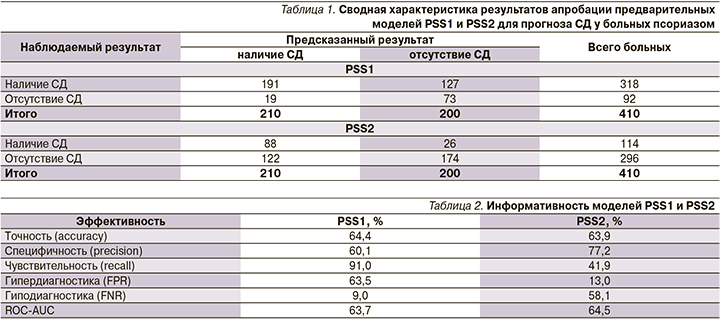
Качество результатов валидации полученных прогнозов оказалось неудовлетворительным. Поэтому было принято решение о модификации применения шкал для повышения точности предсказания. Для начала был построен график по суммам накопленных баллов по каждому пациенту. Мы получили, что области, где есть только пациенты с СД (желтая область) и без СД (зеленая область), четко выделяются (см. рисунок).
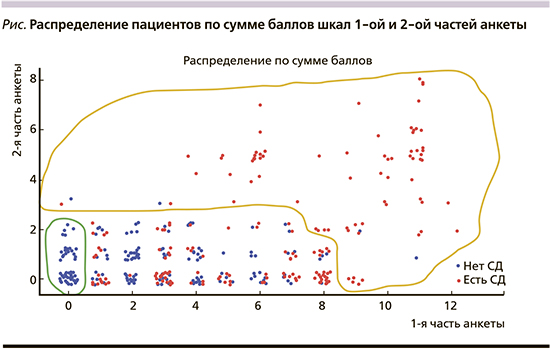
На основе данных рисунка и скорректированной табл. 3 нам удалось получить более точный прогноз. Но этот точный прогноз включил ответ по наличию или отсутствию СД лишь для 51 (12,4%) пациента. Остальные 359 (87,6%) пациентов получали рекомендацию консультации эндокринолога и скрининг 1 раз в 6 месяцев. Но часть из них уже сейчас имели СД и нуждались в лечении.

Для решения этого вопроса на заключительном этапе были проведены однофакторные логистические регрессы по каждому фактору, отброшены статистически незначимые факторы, а затем на основе оставшихся факторов проведена МЛР с использованием модели Backward Stepwise (Likelihood Ratio). Данный метод применяется для предсказания вероятности возникновения некоторого события по значениям множества признаков. Для этого в математическую модель вводится зависимая переменная, принимающая лишь одно из двух значений: 0 (событие не произошло) и 1 (событие произошло), а также множество независимых переменных (признаков, или предикторов), на основе значений которых требуется вычислить вероятность принятия того или иного значения зависимой переменной [5].
Однофакторный логистический регресс
Исследование показало, что шансы развития СД у пациентов с псориазом статистически значимо выше (р<0,05) при наличии следующих признаков (жалобы пациента; табл. 4): повышение уровня глюкозы за последнее время — 1208,18 [73,97; 19732,63]; повышение артериального давления - 20,03 [12,0; 33,42]; плохая заживляемость ран — 18,28 [11,08; 30,17]; сухость во рту - 9,5 [5,33; 16,94]; боли в ногах - 8,86 [5,45; 14,38]; потеря веса - 6,0 [1,33; 27,16]; увеличение количества мочи - 5,57 [3,0; 10,33]; жажда - 3,78 [2,35; 6,08]; прибавка веса - 3,34 [2,23; 5,0]; кожный зуд - 2,35 [1,58; 3,49]; СД у родственников - 1,72 [1,08; 2,75].
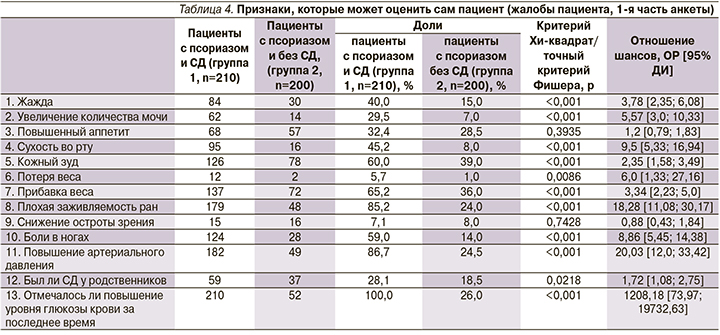
Следующие критерии могут быть исключены из моделипредсказания,т. к. шансы встретить пациента с этими факторами среди пациентов с псориазом и СД сопоставимо с шансом встретить эти факторы среди пациентов с псориазом без СД (причина: 95% ДИ, ОШ содержит 1): повышенный аппетит - 1,2 [0,79; 1,83]; снижение остроты зрения - 0,88 [0,43; 1,84].
Исследование показало, что шансы развития СД у пациентов с псориазом статистически значимо выше (р <0,05) при наличии следующих признаков (кожных маркеров; табл. 5): очаги поражения в крупных складках - 8,89 [4,65; 16,98]; стрии - 6,62 [2,26; 19,39]; симптом псориатического треугольника - 5,78 [3,17; 10,54]; зуд различной степени интенсивности - 5,29 [2,73; 10,25]; кандидоз - 3,59 [1,42; 9,1]; ограниченная подвижность суставов - 2,57 [1,2; 5,49]; повышенная сухость кожных покровов - 2,02 [1,19; 3,43].
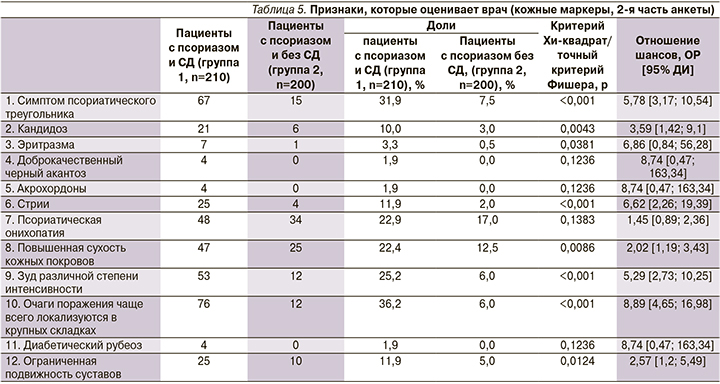
Следующие критерии могут быть исключены из модели предсказания, т.к. шансы встретить пациента с этими факторами среди пациентов с псориазом и СД сопоставимы с шансом встретить эти факторы среди пациентов с псориазом без СД: доброкачественный черный акантоз - 8,74 [0,47; 163,34]; акрохордоны - 8,74 [0,47; 163,34]; диабетический рубеоз - 8,74 [0,47; 163,34]; эритразма - 6,86 [0,84; 56,28]; псориатическая онихопатия - 1,45 [0,89; 2,36].
Множественный логистический регресс
Все сказанное выше предопределило выбор факторов в качестве признаков (независимых факторов/предикторов) для включения в математическую модель прогнозирования СД. Значения параметров, указанные в табл. 6 , свидетельствуют: все выделенные нами факторы являются предиктором развития СД у больных псориазом. При этом влияние выбранных признаков на конечный результат статистически значимо (р<0,05). Данное обстоятельство позволило нам выделить для валидации три основных прогностических теста «Оценка раннего предупреждения диабета у больных псориазом»: DEWS1, DEWS2 и DEWS1&2: DEWS1 - Diabetes Early Warning Score (1 часть анкеты — субъективные параметры, оцениваемые самим пациентом: жалобы пациента).
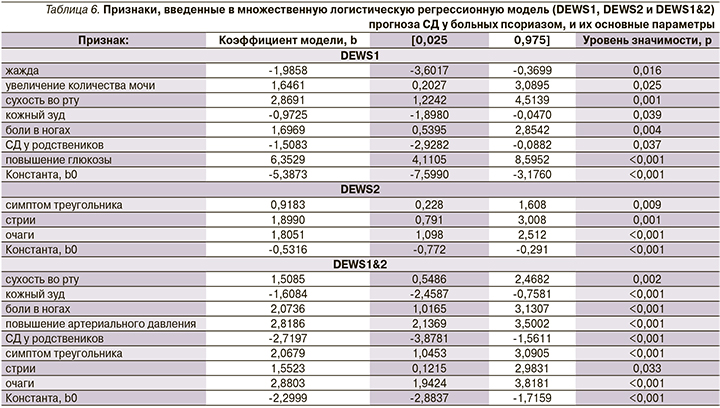
DEWS1 - Diabetes Early Warning Score (2 часть анкеты - объективные параметры, оцениваемые врачом: кожные маркеры).
DEWS1&2 - Diabetes Early Warning Score (1 и 2 часть анкеты - объективные и субъективные параметры, оцениваемые непосредственно пациентом и врачом).
Полученная математическая модель прогноза СД у больных псориазом на основе критериев, определяемых самим пациентом, имеет следующий вид:

где СДБП – вероятность развития СД у больных псориазом.
Для DEWS1: x=-1,9858* (жажда)+1,6461*(увеличение количества мочи)+2,8691* (сухость во рту) -0,9725* (кожный зуд)+1,6969* (боли в ногах) - 1,5083* (СД у родствеников)+6,3529* (повышение глюкозы) - 5,3873*.
Если СДБП составляет более 0,7, пациент относится к группе высокого риска развития СД: наличие СД: СДБП=1 при значении >0,7, отсутствие СД: СДБП=0 при значении <0,7.
Для DEWS2: x=0,9183* (симптом треугольника)+1,8990* (стрии)+ 1,8051* (очаги) - 0,5316; наличие СД: СДБП=1 при значении >0,6, отсутствие СД: СДБП=0 при значении <0,6;
для DEWS1&2: x=1,5085* (сухость во рту) - 1,6084* (кожный зуд)+2,0736* (боли в ногах)+2,8186* (повышение артериального давения) - 2,7197* (СД у родствеников)+2,0679* (симптом треугольника)+1,5523* (стрии)+2,8803* (очаги) - 2,2999; наличие СД: СДБП=1 при значении >0,3, отсутствие СД: СДБП=0 при значении <0,3.
Для оценки качества построенных моделей+результаты табл. 3 и определения ее информативности (точности прогноза) мы рассчитали вероятность развития СД у больных псориазом, после чего сравнили полученные результаты с реальными данными в каждом конкретном наблюдении (табл. 7).

Нами получена математическая модель, позволяющая прогнозировать развитие СД у больных псориазом. При этом установлено, что наилучшую прогностическую силу имеет 1-я модель (DEWS1) по всем изучаемым параметрам эффективности (табл. 8).

Из табл. 8 следует, что DEWS1 имеет максимальную точность (91,2%). При этом его гипердиагностика составляет 16,0%, что не так страшно, т.к. может угрожать лишь дополнительным визитом к врачу. Более опасна гиподиагностика (1,9%), когда не будет выявлен СД, если он есть.
Однако, поскольку жадобы пациента имеют субъективный характер, а кожные маркеры — это объективные параметры, для практики мы рекомендуем использовать шкалу DEWS1&2+ анные табл. 3 расчетов.
В прогнозе СД у пациентов с псориазом площадь под ROC-кривой шкалы DEWS1 (0,937 [95% ДИ: 0,909; 0,956]) статистически значимо превосходила площади под ROC-кривыми шкал DEWS2 (0,698 [95% ДИ: 0,651; 0,740]), DEWS1&2 (0,854 [95% ДИ: 0,816; 0,885]), PSS1 (0,637 [95% ДИ: 0,589; 0,682]) и PSS2 (0,649 [95% ДИ: 0,601; 0,693]). Между площадями под характеристическими кривыми шкал DEWS1 и всеми остальными получено статистически значимое различие (p<0,001), а также DEWS1&2 и всеми остальными получено статистически значимое различие (p <0,001), в то время как между шкалами DEWS2 и PSS1 и PSS2 - нет: DEWS2 и PSS1 (p=0,0619), DEWS2 и PSS2 (p=0,1329), PSS1 и PSS2 (p=0,7154).
Итак, точность моделей по ROC-AUC DEWS1&2 и DEWS1 различается статистически не значимо (p<0,01). Поэтому советуем пользоваться моделью DEWS1&2+табл. 9 сумм баллов для прогнозирования наличия СД у пациентов с псориазом, как максимально учитывающую объективные (кожные маркеры) и субъективные факторы (жалобы пациента).

Обсуждение
Предугадать наличие СД или его отсутствие без использования традиционных методов лабораторной и инструментальной диагностики почти невозможно. С помощью проведенного анализа всех возможных факторов (объективных [кожные маркеры] и субъективных [жалобы пациента]) была построена модель для предсказания СД у пациентов с псориазом.
Точность полученной модели DEWS1&2+таблица сумм баллов прогнозирования СД у пациентов с псориазом составляет 85,6%. Таким образом, предлагаемая анкета (1-я и 2-я части) служит отличным инструментом для раннего скрининга нарушений углеводного обмена у больных псориазом. Мы не нашли в современной доступной литературе сведений, подтверждающих или опровергающих эти данные.
Заключение
Признание псориаза системным заболеванием, характеризующимся хроническим воспалением, распространенным дисиммунным фоном и дисметаболическим окружением, позволяет расширить профилактический и терапевтический подход к нему. Исследование продемонстрировало, что разработанная анкета диабет-скрининга - доступный и достоверный метод ранней диагностики нарушений углеводного обмена у больных псориазом.
Максимальной предсказательной способностью в отношении риска развития СД обладает сочетание следующих признаков: жажда, увеличение количества мочи, сухость во рту, кожный зуд, боли в ногах, СД и повышение уровня глюкозы крови за последнее время. Предлагаемый способ высокоинформативен. Он эффективен, доступен и может найти широкое применение в клинической практике.
Модель позволяет быстро и легко отнести больного к группе пациентов с СД на основании ответов на вопросы анкеты и назначить соответствующую профилактику. Нами получена математическая модель, позволяющая прогнозировать развитие СД у больных псориазом на основе ответов на вопросы анкеты.
По сравнению с оценкой по предварительным стандартным шкалам данные анкеты как предиктор наличия СД у пациентов обладает большей прогностической ценностью, чем первоначально предложенный вариант расчета.
Новая предложенная шкала DEWS1&2+таблица сумм баллов имеет большую статистически значимую точность по данным анкеты «Диабет-скрининг у пациентов с псориазом».



